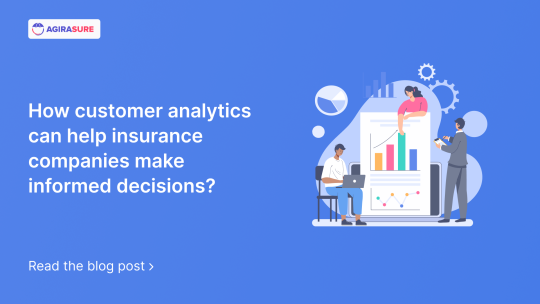Don't wanna be here? Send us removal request.
Text
Are insurtech companies threat to old-school P&C insurance companies?
In the ever-evolving landscape of insurance, Insurtech companies have emerged as dynamic challengers to the traditional Property and Casualty (P&C) insurance firms. The threat they pose is not just disruptive but transformative, pushing the boundaries of conventional practices.
Insurtech companies leverage cutting-edge technologies, data analytics, and a customer-centric approach to redefine the insurance experience. Their nimble structures allow for quick adaptation to market trends, efficient operations, and tailored customer interactions. This poses a significant challenge to the often rigid structures and legacy systems of traditional P&C insurers.
Customer expectations are evolving rapidly, and Insurtechs are quick to meet these demands with personalized, tech-driven solutions. From streamlined claims processes to real-time risk assessments, these newcomers are reshaping the industry's narrative.
However, the traditional players aren't standing idly by. Many are investing heavily in digital transformation, adopting technologies and partnerships to stay relevant. The race is on to combine the strengths of established credibility with the agility of technological innovation.
Ultimately, it's not just a matter of competition but collaboration. P&C insurance companies that embrace the technological shift, perhaps by partnering with or integrating aspects of Insurtech approaches, stand to not only survive but thrive in this dynamic ecosystem. The key lies in finding a harmonious balance between tradition and innovation, ensuring the industry evolves to meet the ever-changing needs of the modern consumer.
0 notes
Text
Best freshworks integration tips for businesses in 2024
Elevate your business efficiency with these top tips for seamless Freshworks integration. As a leading Freshworks consultancy agency, we understand the nuances of making the most out of this robust platform.
1. Tailor integrations to your workflow: Customize Freshworks integrations to align with your specific business processes. Whether it's automating ticket creation or syncing customer data, adapt the platform to suit your workflow seamlessly.
2. Leverage cross-application connectivity: Integrate Freshworks with other essential tools your team uses daily. This enhances collaboration and ensures that data flows seamlessly across different applications, creating a unified work environment.
3. Implement smart automation: Maximize the power of automation within Freshworks. Utilize smart bots for routine tasks, allowing your team to focus on more complex and strategic aspects of customer engagement.
4. Ensure data accuracy: Regularly audit and validate data integrity across integrated systems. Accurate data ensures that your team makes informed decisions, providing a more reliable foundation for customer interactions.
5. Stay informed with analytics: Leverage analytics tools integrated with Freshworks to gain insights into customer interactions. Monitor trends, measure performance, and refine strategies based on data-driven decisions.
As your Freshworks consultancy agency, we emphasize a tailored approach to integration, ensuring that every facet of your business benefits from the platform's capabilities. With these tips, unlock the full potential of Freshworks, creating a seamless and efficient customer support ecosystem.
0 notes
Text
How can insurance companies moderate premiums with telematics?
In the realm of insurance, telematics is transforming the game, offering a dynamic approach to premium moderation that benefits both insurers and policyholders.
1. Precision in risk assessment
Telematics, utilizing real-time data from IoT devices in vehicles, provides insurers with a granular understanding of policyholders' driving behavior. This precision allows for a more accurate risk assessment, moving beyond traditional demographic factors and offering personalized premiums based on actual driving habits
2. Safe driving rewards
With telematics, safe driving doesn't just enhance road safety; it also impacts premiums. Insurers can incentivize policyholders by offering discounts or rewards for responsible driving behavior. This not only promotes safer roads but also cultivates a mutually beneficial relationship between insurers and insured.
3. Personalized premiums for usage
Telematics enables the introduction of usage-based insurance (UBI), allowing policyholders to pay premiums based on their actual vehicle usage. Those who drive less frequently or during low-risk hours can enjoy lower premiums, making insurance costs more reflective of individual behaviors.
4. Proactive risk management
Telematics doesn't just passively collect data; it empowers insurers to actively manage risks. By identifying trends in driving behavior, insurers can proactively engage with policyholders, offering personalized tips for safer driving and potentially reducing the likelihood of claims.
5. Quick response to incidents
In the unfortunate event of an accident, telematics provides insurers with immediate and accurate data. These speeds up the claims process, allowing for quicker resolutions and minimizing fraudulent claims.
In today's era of digital innovation, telematics is revolutionizing the insurance landscape. It's not just about cutting costs; it's forging a partnership between insurers and policyholders. This collaborative approach extends beyond financial benefits, actively encouraging safer roads and creating a more personalized insurance experience.
0 notes
Text
3 Core technologies P&C insurance companies must invest in 2024

As we step into 2024, Property and Casualty (P&C) insurance companies are wise to strategically invest in core technologies that redefine the industry landscape.
1. Artificial Intelligence (AI) and Machine Learning (ML):
Embracing AI and ML is pivotal for P&C insurers. These technologies empower data-driven decision-making, enhancing risk assessment, fraud detection, and customer service. Predictive analytics, powered by AI, enables insurers to anticipate and mitigate risks more effectively, resulting in improved underwriting processes and enhanced customer experiences.
2. Blockchain for Enhanced Security and Efficiency:
Blockchain technology is gaining momentum in P&C insurance due to its ability to enhance security, transparency, and operational efficiency. By leveraging blockchain, insurers can streamline claims processing, reduce fraud, and ensure the integrity of policyholder data. Smart contracts on the blockchain automate and secure policy execution, leading to faster settlements and increased trust between insurers and clients.
3. Insurtech Integrations for Customer-Centric Solutions:
Investing in Insurtech collaborations and integrations is crucial for staying competitive. P&C insurers should explore partnerships with technology-driven startups to enhance customer experiences through innovative solutions. Integrating Insurtech solutions can improve customer engagement, simplify policy management, and provide personalized offerings tailored to individual needs. In summary, the strategic investment in AI and ML, blockchain technology, and collaborative Insurtech solutions positions P&C insurance companies at the forefront of innovation. These technologies not only optimize internal operations but also elevate the overall customer experience, fostering growth and resilience in an evolving insurance landscape.
0 notes
Text
Difference between conventional app development vs blockchain app development

Conventional app development and blockchain app development represent distinct approaches, each with unique characteristics and implications for the applications they produce.
In conventional app development, traditional databases and centralized servers are the norm. The application relies on a client-server architecture, where user data and processes are stored and managed centrally. This model is well-established, with widespread use in various industries. The development process involves selecting a suitable programming language, database, and framework based on the project requirements.
On the other hand, blockchain app development introduces a decentralized and distributed ledger system. Blockchain, the underlying technology for cryptocurrencies like Bitcoin, enables transparent, secure, and tamper-resistant data storage. Unlike conventional apps, blockchain apps do not rely on a single central authority. Instead, they utilize a network of nodes to validate and record transactions across a shared ledger. Smart contracts, self-executing agreements with the terms written in code, are often employed for automation.
Key differences
1. Decentralization
- Conventional: Centralized, with data and processes managed on a single server.
- Blockchain: Decentralized, utilizing a distributed ledger across a network of nodes.
2. Data security
- Conventional: Relies on security measures implemented by the centralized server.
- Blockchain: Offers enhanced security through cryptographic techniques and decentralization, making it resistant to tampering.
3. Trust and transparency
- Conventional: Trust is placed in a central authority; transparency may be limited.
- Blockchain: Trust is distributed across the network; transparency is inherent, as all participants can view the immutable ledger.
4. Smart contracts
- Conventional: Typically lacks automated, self-executing agreements.
- Blockchain: Employs smart contracts for automated and trustless execution of predefined terms.
5. Database architecture
- Conventional: Relies on traditional database systems.
- Blockchain: Utilizes a distributed ledger as the database, ensuring consensus and integrity.
In summary, while conventional app development follows well-established practices with centralized architecture, blockchain app development introduces decentralized, transparent, and secure features through the innovative use of blockchain technology. The choice between the two depends on the specific requirements and objectives of the application being developed.
0 notes
Text
Why are virtual assistants important for insurance companies?

Virtual assistants play a pivotal role in the modernization and efficiency of insurance companies, offering a range of benefits that enhance customer service, streamline operations, and optimize decision-making processes.
Firstly, virtual assistants significantly improve customer interactions. By providing instant responses to inquiries, guiding users through policy details, and facilitating claim processes, these AI-driven assistants enhance customer satisfaction. This leads to a more positive customer experience and helps in building trust between the insured and the insurance provider.
Secondly, virtual assistants contribute to operational efficiency. They automate routine tasks, such as data entry and policy management, reducing the administrative burden on human staff. This allows employees to focus on more complex tasks that require human expertise, ultimately increasing overall productivity within the company.
Moreover, virtual assistants can aid in risk assessment and fraud detection. Advanced algorithms enable these assistants to analyze large datasets, identify patterns, and detect anomalies that may indicate fraudulent activities. This not only helps in minimizing risks for the insurance company but also ensures fair pricing for policyholders.
In the realm of marketing and sales, virtual assistants prove invaluable. They can engage potential customers, provide quotes, and recommend suitable coverage options based on individual needs. This personalized approach contributes to effective lead generation and conversion.
In conclusion, virtual assistants are essential for insurance companies as they elevate customer service, enhance operational efficiency, aid in risk management, and contribute to the overall growth and success of the insurance business in an increasingly digital landscape.
0 notes
Text
The Metaverse and the Future of Virtual Collaboration

The metaverse, a collective virtual shared space, is reshaping the way businesses collaborate. It goes beyond traditional video conferencing, offering immersive and interactive environments where teams can meet, brainstorm, and work together in a three-dimensional digital realm.
Enhancing Remote Collaboration
As remote work becomes the norm, the metaverse provides a solution to the limitations of conventional virtual meetings. It enables more natural interactions, fostering a sense of presence and closeness among team members, despite physical distances. Virtual offices and meeting spaces within the metaverse create an environment that transcends the flatness of traditional video calls. https://www.agiratech.com/web-3/metaverse
Innovative Tools and Solutions
The metaverse isn't just a virtual meeting room; it's a dynamic ecosystem equipped with innovative tools. From collaborative whiteboards and 3D models to virtual reality (VR) presentations, businesses can leverage a range of applications that enhance creativity and productivity in ways previously unimaginable.
Global Connectivity and Inclusivity
One of the metaverse's strengths is its potential to connect people globally, breaking down geographical barriers. This fosters a more inclusive environment, allowing diverse teams to collaborate seamlessly. Businesses can tap into a worldwide talent pool without concerns about physical proximity.
Challenges and Considerations
While the metaverse holds immense promise, businesses must navigate challenges such as privacy concerns, digital security, and the need for universally accepted standards. Addressing these issues is crucial to ensure a safe and effective virtual collaboration space.
Strategic Integration for Business Success
To thrive in the evolving landscape, businesses must strategically integrate the metaverse into their operations. This involves not only adopting the right technologies but also cultivating a culture that embraces virtual collaboration, encouraging creativity, and leveraging the metaverse's potential for innovation.
In conclusion, the metaverse represents a paradigm shift in virtual collaboration for businesses. By embracing this transformative technology, organizations can foster global connectivity, enhance remote collaboration, and unlock new levels of creativity, positioning themselves at the forefront of the future of work.
1 note
·
View note
Text
How RPA can help you automate HR processes?
Robotic Process Automation (RPA) is a game-changer for automating HR processes, streamlining workflows, and enhancing overall efficiency. RPA enables the automation of repetitive, rule-based tasks, allowing HR professionals to focus on more strategic and complex aspects of their roles. Time-consuming activities like data entry, payroll processing, and employee onboarding can be automated, reducing manual errors and freeing up valuable human resources.
Moreover, RPA facilitates seamless integration with existing HR systems, ensuring a cohesive and synchronized approach to data management. The speed and accuracy of RPA contribute to faster and error-free payroll calculations, ensuring employees are compensated accurately and on time. Additionally, routine tasks such as leave requests, attendance tracking, and compliance reporting can be automated, saving time and reducing administrative burdens.
By deploying RPA in HR processes, organizations can improve data accuracy, accelerate response times, and enhance employee satisfaction. The technology allows HR teams to reallocate their focus towards strategic initiatives, fostering a more proactive and agile approach to workforce management. In essence, RPA in HR processes represents a powerful tool for optimizing operational efficiency and elevating the overall employee experience within organizations.
0 notes
Text
How does AgiraSure transform subrogation processes with blockchain?
AgiraSure revolutionizes the subrogation process by leveraging the transformative power of blockchain technology. This innovative approach brings efficiency, transparency, and security to an integral facet of the insurance industry.
Transformative aspects
- Smart contracts: AgiraSure employs blockchain's smart contracts to automate and execute subrogation agreements seamlessly, minimizing manual intervention.
- Immutable records: Blockchain's immutability ensures tamper-proof subrogation data, enhancing trust and preventing disputes.
- Real-time visibility: The decentralized nature of blockchain provides real-time transparency into subrogation transactions, reducing delays for quicker resolutions.
- Enhanced security: Cryptographic techniques and distributed ledger technology in AgiraSure's blockchain ensure robust security, safeguarding sensitive subrogation data.
- Cost efficiency: By eliminating intermediaries and automating processes, AgiraSure's blockchain reduces administrative costs, accelerating subrogation settlements for a more cost-effective solution.
Conclusion
AgiraSure's application of blockchain in subrogation not only optimizes operational efficiency but also establishes a new standard for transparency and security in the insurance industry, ultimately providing a more agile and cost-effective solution for insurance companies.
0 notes
Text
Product development: From idea to launch

Starting on a product development journey begins with a rock-solid idea. In this initial phase, it's essential to engage in thorough market research, identifying gaps and envisioning a solution that genuinely addresses a need.
1. Collaboration with Experts:
Partnering with seasoned product development companies during the ideation stage proves invaluable. Their expertise offers insights into market trends and technological possibilities, elevating the concept and setting a strong foundation for the journey ahead.
2. Design and Development:
As the concept solidifies, the design and development phase take center stage. Skilled professionals work to transform ideas into tangible prototypes, continually refining and iterating to ensure optimal functionality and exceptional user experience.
3. Testing:
Testing becomes a critical checkpoint, allowing for adjustments and enhancements before the product reaches the final stages of production. Product development companies bring their expertise in quality assurance, ensuring that the end result meets the highest standards.
4. Launch Strategy:
The highly anticipated launch is a culmination of strategic marketing and distribution plans. Collaborating with product development companies streamlines this process, leveraging their expertise in market positioning and outreach to ensure a successful product launch.
In conclusion, the journey from idea to launch is a collaborative effort, and aligning with proficient product development companies can transform innovative concepts into successful, market-ready products.
0 notes
Text
How can using customer & agent portals simply operations for P&C insurance companies?

In the fast-paced world of Property and Casualty (P&C) insurance, simplicity and efficiency are paramount. Enter the game-changers: customer and agent portals. These digital platforms act as the command center for insurance operations, creating a transformative impact.
Customer portals:
These portals empower policyholders with unprecedented control and accessibility. From policy management to claims tracking, customers can navigate their insurance journey effortlessly. The ability to view policy details, make payments, and initiate claims in real-time enhances customer satisfaction. The transparency offered by customer portals fosters trust and engagement, creating a positive experience.
Agent portals: On the flip side, agent portals revolutionize the way insurance professionals operate. These platforms offer a centralized hub for managing policies, processing claims, and interacting with clients. Agents can access real-time data, allowing for quick and informed decision-making. The efficiency gained from streamlined processes and the ability to promptly respond to customer inquiries enhances overall agent productivity.
Operational simplicity: The integration of customer and agent portals simplifies day-to-day operations for P&C insurance companies. Policy updates, document submissions, and communication between all stakeholders become seamless, reducing administrative burdens and minimizing errors. The result is a more agile, responsive, and customer-centric insurance operation.
In conclusion, the adoption of customer and agent portals in P&C insurance heralds a new era of simplicity and efficiency. By placing control in the hands of customers and providing agents with powerful tools, these portals are transforming insurance operations, fostering stronger customer relationships, and ensuring a competitive edge in the industry.
0 notes
Text
How integrating salesforce can streamline sales processes?

In the ever-evolving world of sales, keeping pace means embracing innovation. Meet Salesforce, it's a game-changer designed to bring efficiency and effectiveness to every facet of your sales journey. From centralizing customer insights to automating everyday tasks, providing real-time analytics, fostering teamwork, and offering tailor-made solutions, Salesforce is more than just a CRM – it's the transformative force your sales operation needs.
Get to know your customers better
With Salesforce, all your customer info is in one place. It's like having a super-smart assistant that shows you everything about a customer – what they like, what they've done, and what they might need next.
Less work, more results
Salesforce isn't just for managing customers; it's your helper for everyday tasks. It does things like sending emails and handling data entry, so your team can focus on important stuff. It's like having a second pair of hands to make sure everything gets done, and done right.
Smart insights for smarter choices
Salesforce gives you super-smart analytics. It's like having a crystal ball that shows you what's happening right now. With this info, you can make smart choices, see what people like, and make your sales strategies even better.
Teamwork made easy
Communication is key, and Salesforce makes it a breeze. Your team can share info and updates in real-time. It's like everyone being on the same page, working together smoothly.
Made just for you
Every business is different, and Salesforce gets that. You can change how it works to fit your needs. It's like having a tool that's built just for you, making your work easier and more satisfying.
In a nutshell, Salesforce isn't just a tool; it's a game-changer for your sales. From knowing your customers better to saving time, getting smart insights, easy teamwork, and customization, Salesforce is the secret ingredient for a more successful sales game.
#salesforceintegration #salesforcecustomization #salesforcesolutions
0 notes
Text
Why managed IT services are essential for small businesses?

In the world of small businesses, managing tech can be a challenge. Enter Managed IT Services – a crucial support system. Let's break down why these services are essential for small businesses.
1. Cost Savings: Managed IT turns unpredictable tech expenses into a budget-friendly solution, saving money for other needs.
2. 24/7 Support: Offering round-the-clock tech support, Managed IT tackles issues before they become major problems, providing peace of mind.
3. Expert Assistance: Bringing in specialized knowledge, Managed IT solves tech challenges that small businesses might find difficult.
4. Scalability: As small businesses grow, Managed IT adjusts, providing tailored support for different business sizes.
5. Proactive Problem Solving: Managed IT doesn't wait for trouble; it prevents issues, ensuring smooth business operations.
In a nutshell, for small businesses, Managed IT Services aren't just support; they're essential for running a smooth, efficient operation.
0 notes
Text
Why insurance companies should use a document management system?

In the fast-paced realm of insurance, the adoption of Document Management Systems (DMS) has become a strategic imperative. These systems serve as the backbone of operational efficiency, offering insurance companies a unified platform to organize, store, and retrieve critical documents. As the industry grapples with an ever-increasing volume of paperwork, DMS emerges as a linchpin, streamlining workflows, reducing errors, and ensuring regulatory compliance.
The pivotal role of DMS unfolds across various facets of insurance operations. From expediting claims processing to facilitating seamless policy management, DMS empowers insurers to navigate complex processes with agility. By digitizing and centralizing document workflows, insurance companies not only enhance internal processes but also elevate customer service by enabling faster response times and improved accuracy.
In an era where information is key, a robust Document Management System is more than a tool—it's a strategic investment for insurers aiming to stay competitive, adaptive, and compliant. Embracing DMS is not just about managing documents; it's about shaping the future of insurance operations in a digitized landscape.
In the dynamic landscape of insurance, document management is a linchpin for success. Discover how AgiraSure's Intelligent Document Processing (IDP) system, fueled by cutting-edge AI, revolutionizes the way insurance companies operate. Streamlining workflows, enhancing accuracy, and boosting efficiency—AgiraSure empowers insurers to navigate the complexities of document management with seamless precision. #Insurtech #AgiraSure #AIInnovation
0 notes
Text
How can customer analytics help insurance companies make informed decisions?

In today's data-driven landscape, insurance companies are using the capabilities of customer analytics to revolutionize decision-making processes. This blog explores how customer analytics empowers insurers to make informed choices, optimize operations, and elevate the overall customer experience.
1. Risk assessment and underwriting
Customer analytics gives insurers a deeper understanding of historical data, enabling more accurate risk assessment and underwriting decisions. This section delves into how insurers leverage data patterns to set premiums, approve policies, and mitigate financial risks.
2. Customer retention and satisfaction
Discover how customer analytics transforms the customer experience. By analyzing customer behaviors, preferences, and feedback, insurers can personalize interactions, fostering loyalty, and satisfaction. This section explores the impact of personalized communication on customer retention.
3. Fraud detection in claims processing
A spotlight on how customer analytics protects against fraudulent activities in the claims process. Insurers can proactively identify suspicious patterns, reducing financial losses and maintaining fair premiums for honest policyholders.
4. Operational efficiency
Explore the role of customer analytics in optimizing internal processes. Insurers can streamline workflows, allocate resources efficiently, and reduce operational costs by analysing customer interactions. This section highlights how data-driven insights enhance overall operating efficiency.
As the insurance industry evolves, adopting customer analytics becomes imperative for insurers seeking a competitive edge. From risk assessment to operational efficiency, the insights derived from customer analytics propel insurance providers towards growth, stability, and a customer-centric approach in an ever-changing market. Embracing customer analytics isn't just a strategic advantage but a necessity for insurers committed to staying ahead in the dynamic landscape.
1 note
·
View note
Text
Blockchain: The Future of Secure Data Management

Blockchain technology is more than just the foundation of cryptocurrencies like Bitcoin; it's a revolutionary force reshaping how we manage data. In this blog post, we'll delve into the basics of blockchain, its workings, and the myriad ways blockchain development services can contribute to data security and management across various management practices across various industries.
Understanding Blockchain
Blockchain, at its core, is a distributed database facilitating secure, transparent, and tamper-proof transactions. Unlike traditional databases, it allows digital information to be distributed without the risk of duplication, providing a robust foundation for digital currencies like Bitcoin.
How Blockchain works: A secure approach to data management
Transactions in a blockchain are verified by computers on a network, making it nearly impossible to alter information without detection. This transparent and tamper-proof system has immense potential applications, from data management to voting and supply chain tracking.
Advantages of Blockchain: transformative benefits for businesses
The benefits of blockchain technology are extensive:
- Security and transparency: Blockchain ensures data security and transparency, vital for trustworthy transactions.
- Efficiency and cost reduction: By eliminating the need for third-party intermediaries, blockchain streamlines processes, saving businesses time and money.
- Decentralization: With no central authority, blockchain decentralizes data management, reducing reliance on third parties.
- Immutability: Data on the blockchain is immutable, safeguarding it against unauthorized alterations.
- Cybersecurity: Blockchain's tamper-proof nature protects against data breaches and cyberattacks.
The Future of Blockchain
While still in its early days, blockchain is set to revolutionize data management, offering a secure, transparent, and efficient way to track and manage transactions globally.
In conclusion, blockchain is not just a technology; it's a paradigm shift with the potential to redefine how businesses operate and secure their data. As technology matures, we anticipate witnessing the widespread adoption of blockchain solutions across industries, ushering in a new era of trust, transparency, and efficiency.
0 notes
Text
5 ways RPA can streamline your business operations

Robotic Process Automation (RPA) is a technology that has been gaining traction in recent years. It is a software that can be programmed to carry out tasks in a software interface that would normally be done by a human. RPA is usually used in instances where a task is repetitive, but vital to operations, such as collecting data from various siloed spreadsheets. This doesn’t just reduce the employee workload, it also reduces the risk of human error, improves accuracy, and can even help businesses ensure that they are compliant with data privacy regulations.
Here are 5 ways RPA can streamline your business operations:
Data mining
RPA can help extract useful data from your company’s vast data storage silos and use them to paint detailed, accurate pictures of customer behavior, product usage, employee engagement, sales figures across different regions, and pretty much anything that is measured using digital datasets. Business transformation RPA is really the only viable way of conducting data mining, as manually trawling through spreadsheets is impossibly slow and has a high chance of fatigue-induced error for humans.
Invoice processing
Invoice processing is one of many important tasks that finance departments undertake. An accidentally added zero could cause mayhem for your organization. Business transformation RPA removes the chance of human error entirely and relieves finance employees from the rote task of editing, checking, and sending invoices. By setting up an RPA bot to match customers and orders and automatically draw up invoices, businesses can save time, increase accuracy, and avoid possible disasters.
Employee onboarding
Automation isn’t reserved only for data mining and finance tasks. It can also have an impact on the human side of a business too. HR departments across the world use automation to help manage crucial areas of the business – an example of this can be found at the beginning of the employee journey. The onboarding process usually consists of background checks, collecting payslip information, references, and more. RPA can help automate these tasks, freeing up HR personnel to focus on more important tasks.
Customer service
RPA can help businesses automate their customer service processes, such as answering frequently asked questions, handling customer complaints, and more. By automating these processes, businesses can save time and money, while also improving customer satisfaction.
Supply chain management
RPA can help businesses automate their supply chain management processes, such as inventory management, order processing, and more. By automating these processes, businesses can save time and money, while also improving accuracy and efficiency.
In conclusion, RPA can help businesses streamline their operations by automating repetitive tasks, reducing the risk of human error, and improving accuracy. By implementing RPA, businesses can save time and money, while also improving customer satisfaction and employee engagement.
2 notes
·
View notes